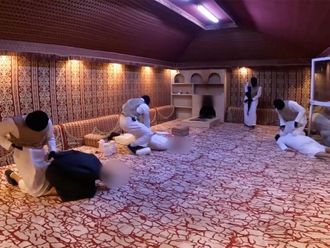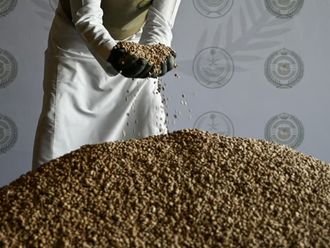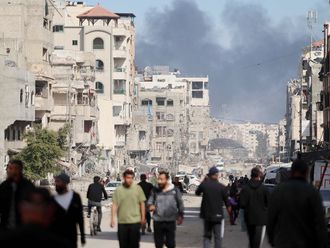
Lahore: Musharraf Ali Farooqi is a renowned novelist and translator. Fond of reading since childhood, he opted to carve his identity through literature and books.
He started by doing translations and the many classic Urdu stories that he translated into English got an overwhelming response in the international press. The Adventures of Amir Hamza is one such example.
He is also the author of two famous novels — The Story of a Widow and Between Clay and Dust — which have been nominated in many national and international awards. Between Clay and Dust was shortlisted for The Man Asian Literary Prize 2012 and long listed for the 2013 DSC Prize for South Asian Literature. The Story of a Widow was shortlisted for the DSC Prize for South Asian Literature 2011, and long listed for the 2010 IMPAC-Dublin Literary Award.
Besides, he is also a reputed storyteller, aiming to instill the love of books in the young generation through literature he has written — children’s fiction Tik-Tik, The Master of Time is one example. To promote literature he has also launched his own publishing house, KITAB. From this publishing house he has printed mostly books for children.
His wife Michelle Farooqi is a talented illustrator, who has made drawings for most of her husband’s children books. In an exclusive interview he talks about himself as a translator, novelist, storyteller and publisher.
You were an avid reader since your childhood. What was the motive at that time and what kind of books did you read?
It is one of the advantages of living in a small city that there are few distractions. Hyderabad, where I grew up, was a relatively quiet city in those days, and I had lots of free time on my hands. The habit of reading formed early in life got me started into my reading life. From newspapers to popular digests to homeopathy manuals, everything was consumed when stories were not at hand.
How did the idea of writing novels come to you and what was the inspiration? What are the difficulties faced when you are writing your first novel?
It just happened, and I started writing the novel. I had not written any short stories before I attempted my first novel, and therefore never plotted anything. There was a lot of confusion about how to stuff all the themes and characters I wanted to write into the novel. It was a struggle, but in the end I found my way out, and learnt how to plot and connect ideas and characters in the process.
Your novel Between Clay and Dust is about the subcontinent’s form of wrestling. Don’t you think that this topic and setting make it limited for the readers of this region only?
I was unsure about it in the beginning, but I did not wish to change anything to make it any more “accessible”. Now that it has been reviewed in the US and Canadian press, I see that everyone does seems to get it. Ideas should be accessible, of course, and as a writer one must be able to express them clearly. But one must not compromise on presenting conflicts of human life and relationships, or falsify them in an effort to make them “accessible”.
In addition to the world of wrestling, you have a subplot and that is the world of courtesans. Your main character in this storyline is Gohar Jan. How did you immerse yourself in her world?
The kotha culture was an integral part of the elite’s life in the subcontinent. It was not difficult to find references and research the subject.
Does the novel glamorise a bygone time? Do you have nostalgia for a bygone time? Is there something the present can learn from the past?
I do not agree that the novel glamorises the past. In fact, I believe that in the matter of individual choices life was far more difficult in the past. The interests of the family and the community as a unit almost always prevailed against the interests of the individual. Ustad Ramzi feels bitter, in part, because Tamami tends to assert himself whenever he gets an opportunity to do so, because those strict holds on life have been broken under which Ustad Ramzi laboured.
What persuaded you to translate books?
When I began translating The Adventures of Amir Hamza, I had a feeling that nobody is going to do it for us if we ourselves do not begin translating our classics and sharing them with the world. That feeling has only become stronger over the years.
What do you see in any piece of literature when you select it for translation?
I now exclusively translate the Urdu classics. My time is mostly taken up by my translation of Tilism-e Hoshruba (www.hoshruba.com), the world’s first magical fantasy epic. I am fascinated by the story and the narrative devices it employs, and I feel that I would learn a great deal as a writer from this effort. Hoshruba is one of world literature’s great works and to be able to read it closely as a translator is a great education. That the world can finally access this story through my translation is also a great reward.
Which writer did you enjoy most while translating his work?
The poet Afzal Ahmad Syed, whom I consider Urdu’s greatest living poet, and one of our great prose writers.
How has your work as a translator helped you in writing novels?
I would say that it has helped me understand the mechanics of narratives.
What are the occupational hazards of being a writer?
One may never get published. One may not make enough money. There is no end to hazards. But this is true of all art and scholarship. A life has to be its own reward for one to carry on with it.
What is the one book/author you feel everyone must read and why?
The Little Prince by Antoine de Saint-Exupéry. Because it is about our mortality.
Every writer is a critic. What do you say about your work as a critic?
Not sure how I can seriously answer this question but I can perhaps safely say that I try not to repeat the idiom and tone in my books.
How many languages do you know and how did you get mastery over them?
I am proficient only in Urdu and English, but I can translate from Sindhi and Persian, and still retain a little French.
Are you translating anything these days?
Yes, the remaining 23 volumes of the magical fantasy Hoshruba. It will keep me busy for the next six to seven years.
You are paying special attention to children’s literature. Would you like to brief something about it and the motives behind this effort?
I feel that without providing good literature to our children we will not make them good and intelligent readers. A great majority of the children’s books published in Pakistan in Urdu are horribly dull. This takes children off reading. They do not find any pleasure in the stories and as a consequence lose interest in reading Urdu. One of the reasons I launched my publishing house KITAB which specialises in publishing children’s literature in Urdu was to change this trend.
What elements do you see as essential in children’s literature?
The elements of wonder, magic and compassion. We now have a crop of parents in Pakistan who find it a virtuous duty to stop children from reading stories which have fantastic elements.
How do you maintain balance between an author and a publisher?
It gets crazy sometimes. The initial few years were too busy and at times exhausting, but now things are shaping up and I have more time to devote to my own writing and translation.
What is the reason that children don’t read as much as they need to?
Children do what they see adults doing. If children do not see adults exploring and reading books, they will not get excited about doing so on their own. And yet I think that if the books are just made accessible to them, they would pick them up and discover them without help from adults.
Why is exposure to reading so limited?
In my opinion the most important thing they could do is to make books accessible to children throughout their childhood, and encourage them to explore them. Picture books are a very important category that introduces children to the magic of books at an early age.
How would you compare our literature to that of authors from the West?
There have been very few studies done in South Asia about the nature of stories and their poetics, so we really cannot compare or discuss the significant differences between our literature and Western literature. However, having studied the dastan genre as its student and translator, I feel that in all our classical stories fate plays a significant part and unfolds in mysterious ways.
When are you planning on writing the next book? What will it be about?
I am writing a new novel. It is a longer work, comprising several books, connected with a frame story.
What are your views on Malala and her cause to promote education in the country?
That little girl deserves the very best that life has to offer. Her cause to promote education in the country should be everyone’s cause.
What is the toughest part about your job?
The work itself is not as hard as getting oneself to the writing desk.












